We’ve heard and seen your pleas for help on our online forums, in letters and e-mails, on our Facebook page and in your Jumping Clinic photo submissions. You want to know to fix those annoying position problems that you just can’t seem to shake, no matter how hard you’ve tried.
To help, Practical Horseman editors dug through 15 years of back issues and thousands of photos (“Can you believe someone wore THAT?”) to find our favorite solutions to your most relentless position challenges. Enjoy reading advice from top experts that is as valuable today as it was back when it first graced the pages of our magazine. As you read through them, you’ll notice that most of the problems are interconnected. It’s no surprise, then, that “work without stirrups” was suggested in every article, in addition to the exercises offered here. (Note: Remember some of these, ahem, “classic” photos were taken years before our current approved headgear rules. As always, we strongly urge you to wear approved headgear whenever you ride.)
1. I look down
Why it’s a problem: When your head is out of alignment, you may collapse forward, tip sideways, bob or wag your head, and impair your vision and ability to turn your horse.
Fix: Your head’s very heavy—so when you hold it up and aligned with your spine (think of keeping your chin about parallel to the ground), you help align the rest of your upper body, too—like a stack of building blocks, every part balanced on the others with a minimum of strain. This alignment helps you ride with relaxed shoulders, arms and back.
Begin a posting trot around the ring and take both reins in your outside hand with a light contact. Raise your inside hand straight out in front of you at shoulder height and keep your eyes on it; extend it to the side, then rotate your extended arm and hand from your shoulder, reaching as far behind you as you comfortably can. As you continue watching your inside hand through these motions, maintain a steady posting trot. Reverse direction and repeat. It sounds simple, and it is—but if you do it for a few minutes each time you ride, it will help you develop balance, feel and the independent use of your eyes and head. —Missy Clark, April 2000
2. I hunch my shoulders and collapse my chest
Why it’s a problem: You round your shoulders forward, collapse your chest and send your center of gravity ahead of your horse’s. Your tension wires itself to your arms, and your forearm muscles visibly tighten. As it spreads like a virus through your body, your knees clutch—which turns them into pivots, sending your heels up and your lower legs back. With your hunched body and dropped chin, breathing becomes a chore; so does zeroing in on your distance to the next fence.
Fix: At the walk, shake out each arm (as you’d do to dislodge a pesky insect) to literally shake away tension. Then take a deep breath (which will relax, lift and open your chest) at the same time that you roll your shoulders up toward your ears, then push them back and down. Repeat this exercise whenever you feel your shoulder muscles tense as if pulling your shoulders up.—Kathy Fletcher, January 2001
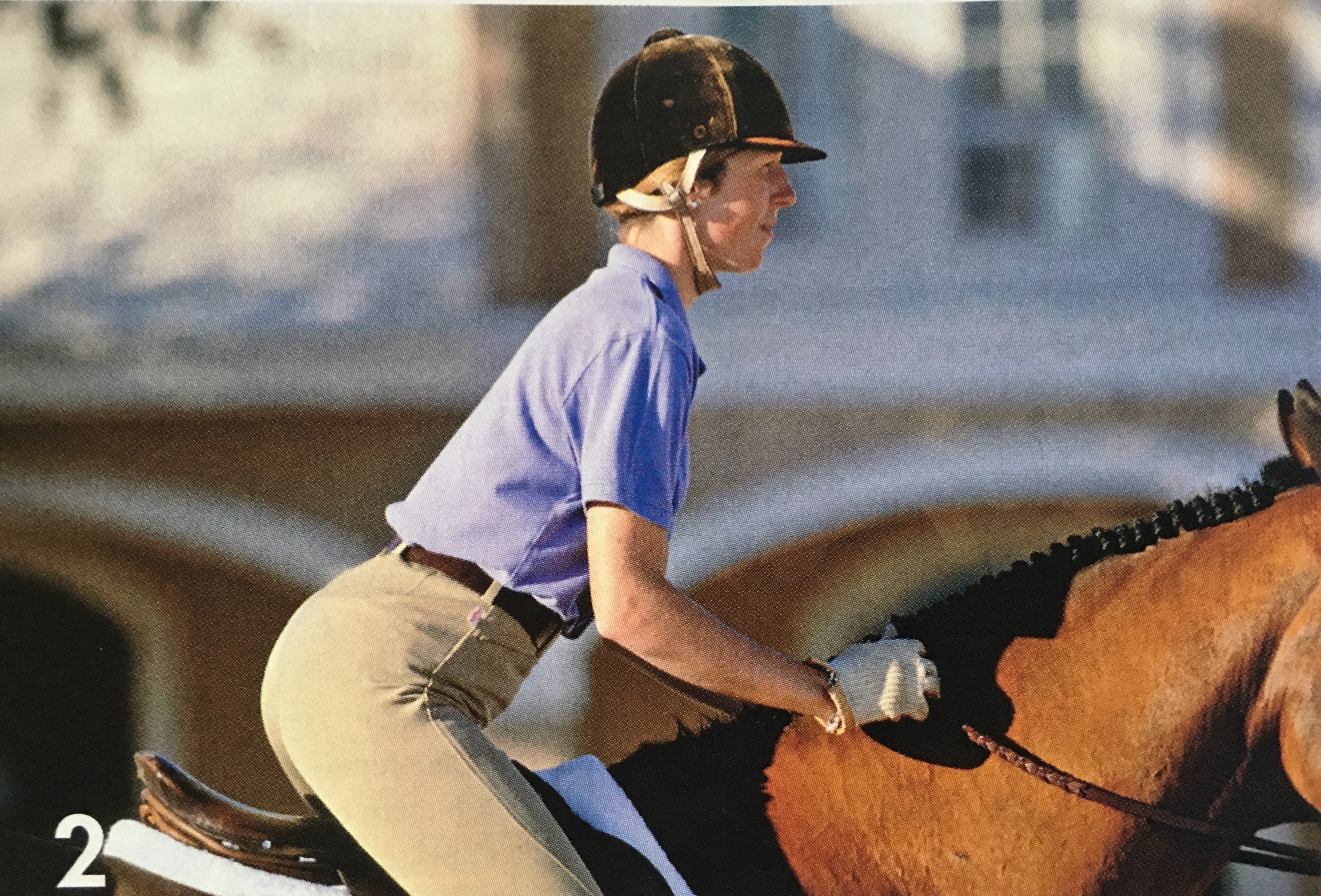
3. I lean at fences with my upper body
Why it’s a problem: You’re heading toward a fence when your upper body drops forward, your knee pinches, your lower leg slides back and you start balancing off your hand. You climb so far up your horse’s neck that he’s on his nose and can’t push from his hind end. Instead of letting him come up and close your angle as he jumps, you close it yourself and “leave the ground before he does.” His only option (if he’s a good guy) is an awkward, weak, you’re-not-sure-if-or-how-it’s-gonna-happen jump—or a flat-out chip. If he’s less than honest, he may step aside and go around—or slam on the brakes and dump you.
Fix: Shorten your stirrups two or three holes and stretch up, which brings the inside of your leg flat against your horse with your toe higher than your heel. This strong base automatically puts your upper body over your center of gravity—leaning is virtually impossible if your base is centered—and forces you to ride the correct motion from the back of your seat to your crotch, rather than riding up and down. And it puts your arms and hands out in front of you. (Too-long stirrups make you use either the back of your leg or your knee as your base of support and neither works. —Tony Workman, November 1998
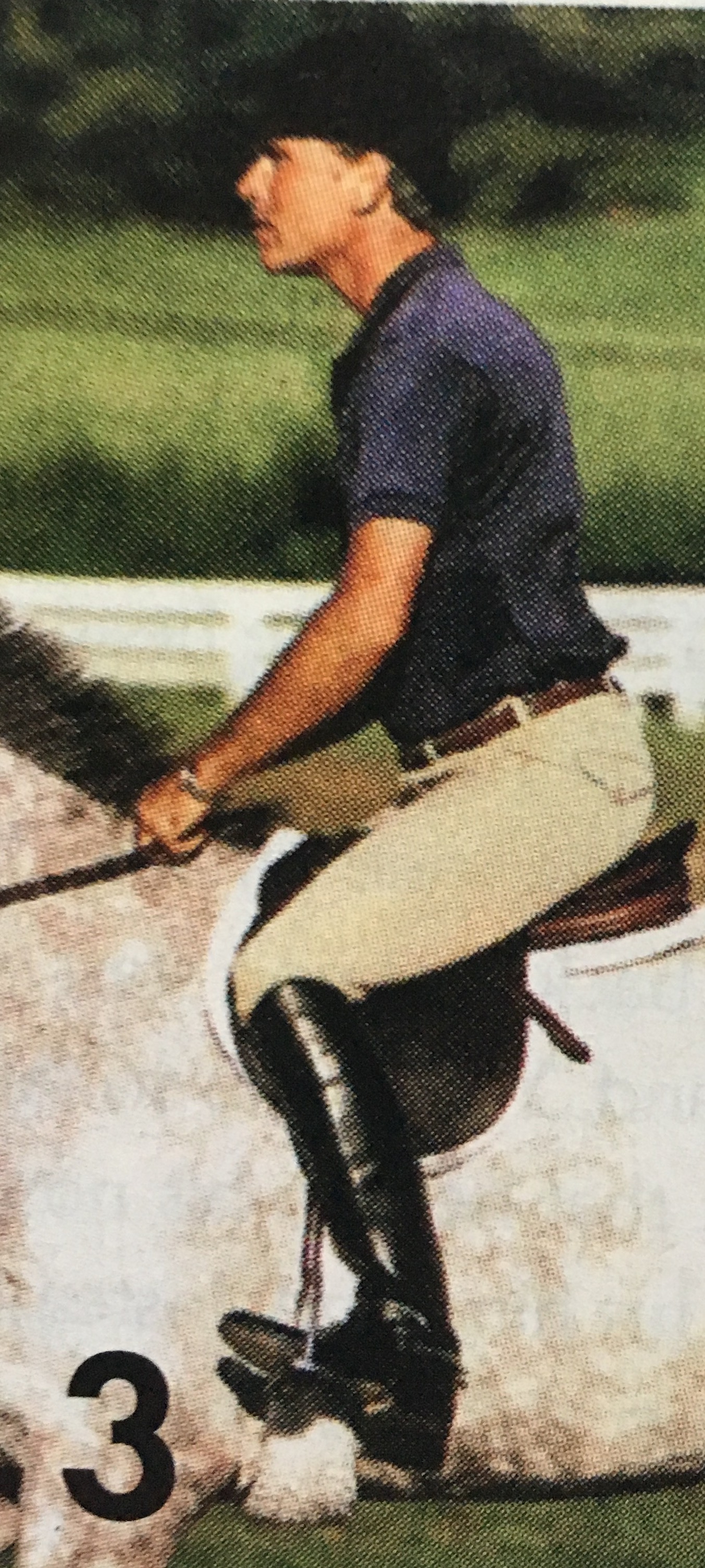
4. I get ahead of my horse’s motion
Why it’s a problem: When you’re ahead of the motion, you’re in front of your horse’s center of gravity. Like leaning with your upper body, this unbalances him and makes pushing off and leaving the ground difficult, especially if you get to a deep distance very close to the fence. Jumping ahead also weakens your security and control and makes you take longer to reorganize after the fence. If your horse stumbles or makes a mistake, he’s less able to recover, and you’re more likely to tumble over his head. Consistently jumping ahead can make your horse quick, unsettled and nervous.
Fix: Set a small crossrail or low vertical about halfway up the long side of your arena with ground poles on both sides so you can jump it in both directions. Pick up a nice working canter tracking right, get in two-point and come through the corner. Pick a focal point at the end of the arena, especially important if you tend to duck and look down. Focus on staying in two-point on the approach and as you jump the fence, make sure your hip angle is at about 25 degrees and stays there with no excessive firing your body forward, standing up, throwing an exaggerated release or ducking. Just canter up in two-point and jump the jump. Once you feel confident doing this with stirrups, try it without, which will automatically keep you from perching and standing way up off your horse. —Jeff Cook, November 2006
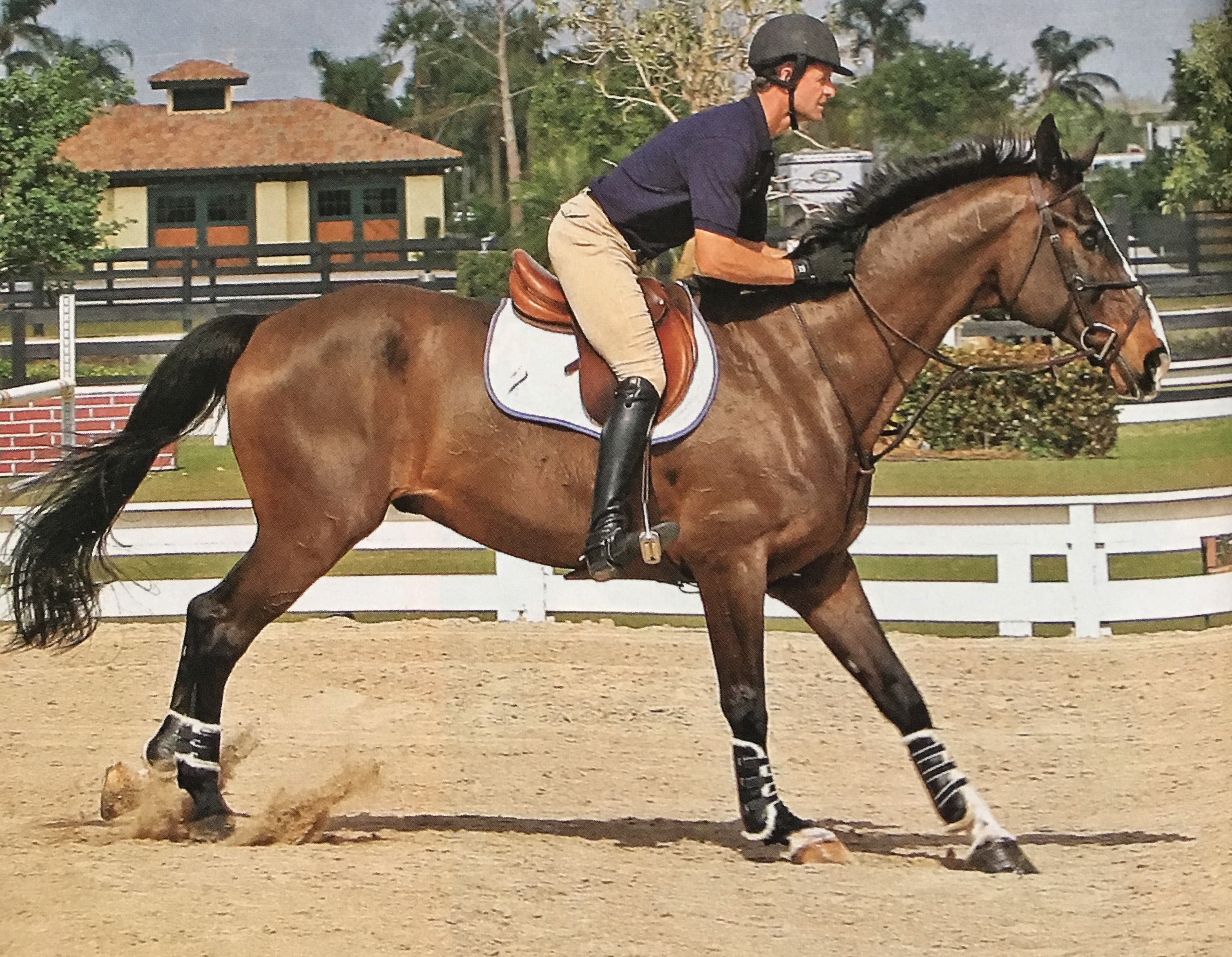
5. I duck over fences Why it’s a problem: Ducking is a last-second mistake; you do it just about when your horse’s front legs leave the ground. You don’t duck on the approach, but most riders who sit behind the motion on the approach end up ducking even more (trying to catch up with their horses) than those who approach in a half-seat. Ducking causes your seat to become very high and forward, making your knee angle almost straight. When your hip has this much closure over the top of the jump, you usually end up too closed when your horse’s feet touch the ground. That throws off your balance, making you pivot on your knee so your lower leg comes back and your heel comes up. All this is happening just when you need your leg securely under you, your heel down and your hip angle open so you can come back to a more upright position and you need a straight line from your elbow to your horse’s mouth to accommodate that position.
Fix: Start with a simple line of two low fences: a pair of two-foot crossrails or verticals set about 60 feet apart. A horse with an average stride can normally trot the first fence and canter down to the second in five strides; if your horse is short- or long-strided, adjust the distance so that the five is comfortable for him. (The purpose of this exercise is to give you the feel of what it’s like to keep your body absolutely still as your horse jumps, not to lengthen or shorten between fences.)
Pick up a trot and head to the first fence. As soon as you have the two fences lined up, and while you’re still several strides from the first, get into your two-point position. Shift your reins into one hand, and position that hand in a short crest release. With the other, grasp the mane about halfway up the neck (approximately where you’d put your hand in a long crest release), so there’s still a slight bend in your elbow. Holding mane this way will isolate your upper body and prevent you from ducking.
Pick out a focal point at the end of the line—say, a tree or a fence post, or a beam if you’re indoors—and look up and ahead all the way through. If you look down, you’ll tend to duck down. Focus on keeping your upper body motionless as your horse jumps the first fence, canters down the five strides and jumps the second fence. Keep your weight in your heels, and don’t let your hip angle change.—Missy Clark, June 1998
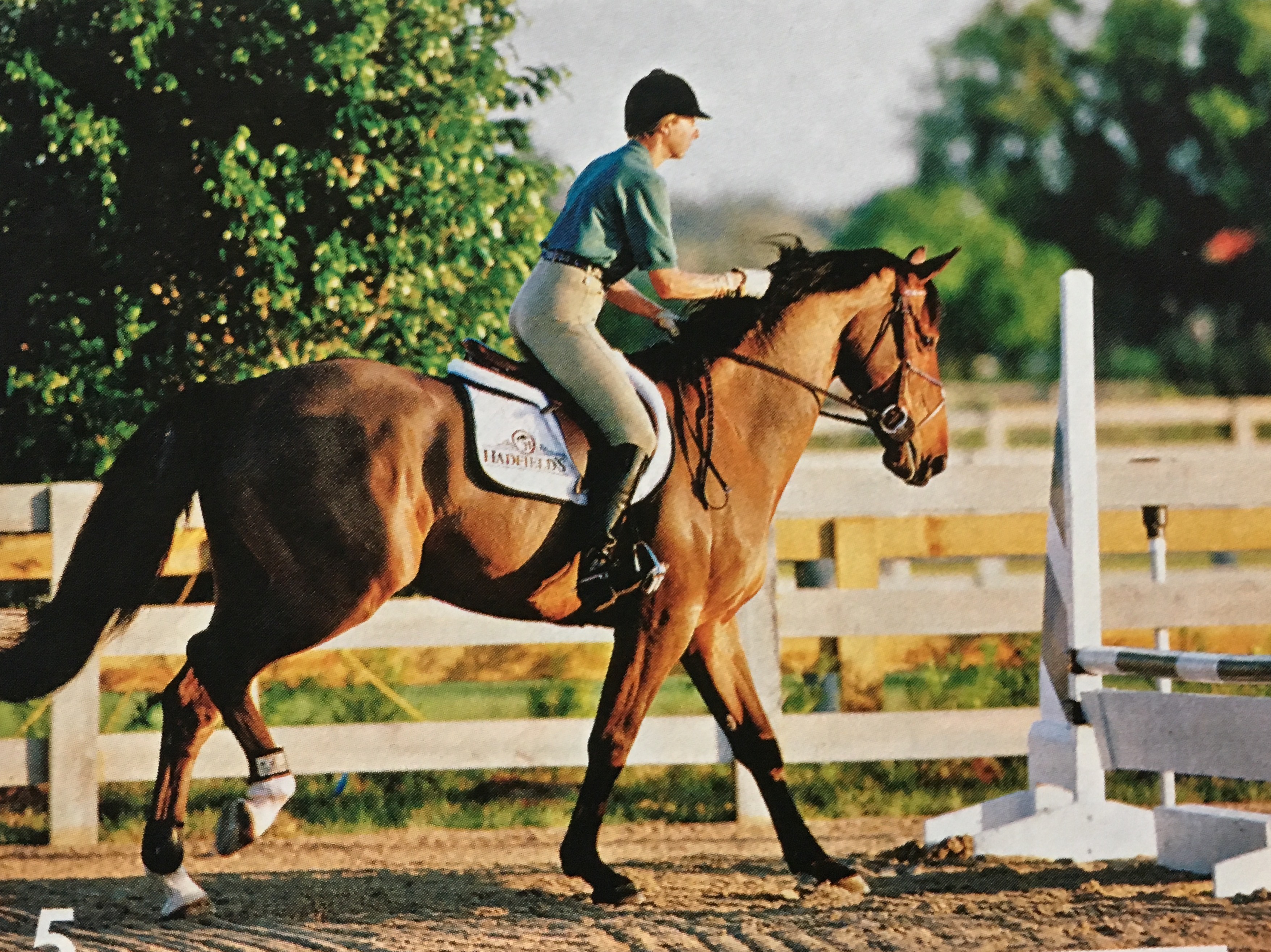
6. I use too much hand on course
Why it’s a problem: It causes you to have trouble seeing distances out of the turns or add strides in lines in an effort to do the exact distance.
Fix: Set a pole on the ground, a crossrail or a low vertical where you’ll have room to make a figure eight of two biggish circles by jumping the fence and tracking to the right, then jumping it again and tracking to the left. The greener your horse is, the bigger your circles will need to be to start. As he becomes more confident and you get the feel of guiding him, you can make the circles smaller and tighter.
Jump the fence straight, then circle to the right, looking where you want your horse to go. If he starts to cut in from your circular track, open your outside rein to invite him back (and to keep his shoulder from bulging), your inside leg pushing him into that outside rein and your inside rein just lying against his neck. If he’s hanging on the outside rein, open your inside rein and rest the outside one on his neck. You’re leading him around with a separated opening rein, not jerking him around.
When you reach the halfway point of that circle, 180 degrees away from the fence, start consciously softening your arms, shoulders, elbows, all the way down, to relax them as you look for and begin allowing yourself to see the distance.—Chris Kappler, April 1999
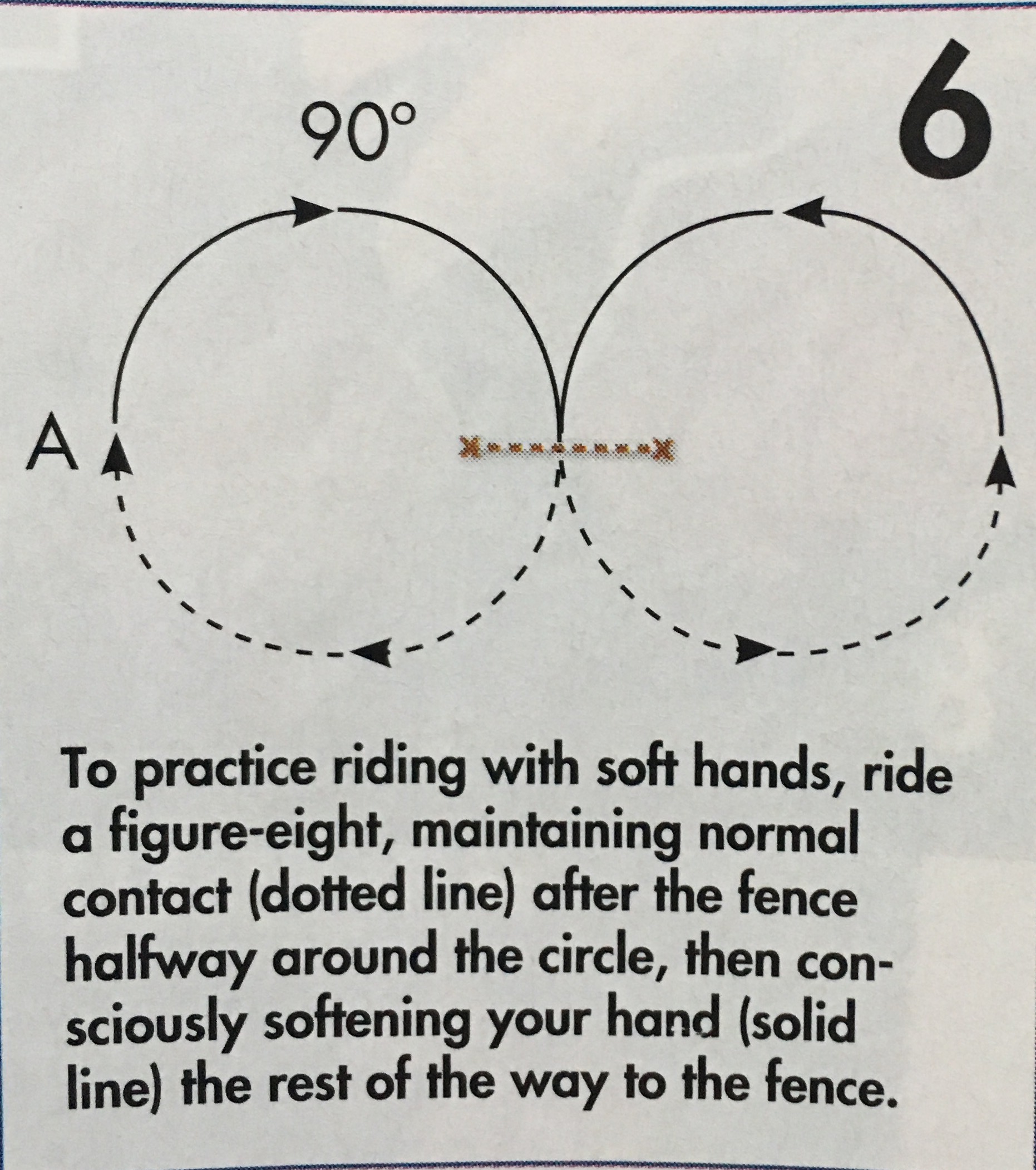
7. I bounce while trying to sit the trot
Why it’s a problem: You are out of phase with the up-and-down motion of your horse’s back. You may go up with him fine, but you don’t come down as fast as he does. That means you’re still descending as he’s coming up again. The saddle collides with your bottom, the impact bounces you higher and you’re even later starting down again.
Fix: Keep the trot fairly slow and quiet. Your “up-down” at a working posting trot happens at a rate of about 75 beats per minute, but the up-down of a working sitting trot happens at about 150 bpm, or twice the rate of the posting trot. And in general, the faster a motion, the more coordination you need to do it. So while you’re practicing, trying to get in sync and keep track of everything else you’re thinking about, slowing things down will just make sitting easier and more doable.
Trot for a few strides; then come back to walk before you start to fall apart. If, as you increase your number of sitting strides, you find you’re losing your position, getting tired or starting to get out of phase, immediately walk and reorganize. The only way you learn to do a movement well is by doing it well. If you press on after your position begins to degrade or you start bouncing, you won’t learn to sit well. You’ll learn to sit badly. Also, think of pushing your saddle down. Any time you’re being bounced, you feel as if you’re out of control. But pushing the saddle down is another way to get yourself to flex or close your hip and almost automatically quicken your descent. And, believe it or not, this empowers you to believe you have control in a situation where your gut is telling you that you don’t. —Sandy Howard, October 2006
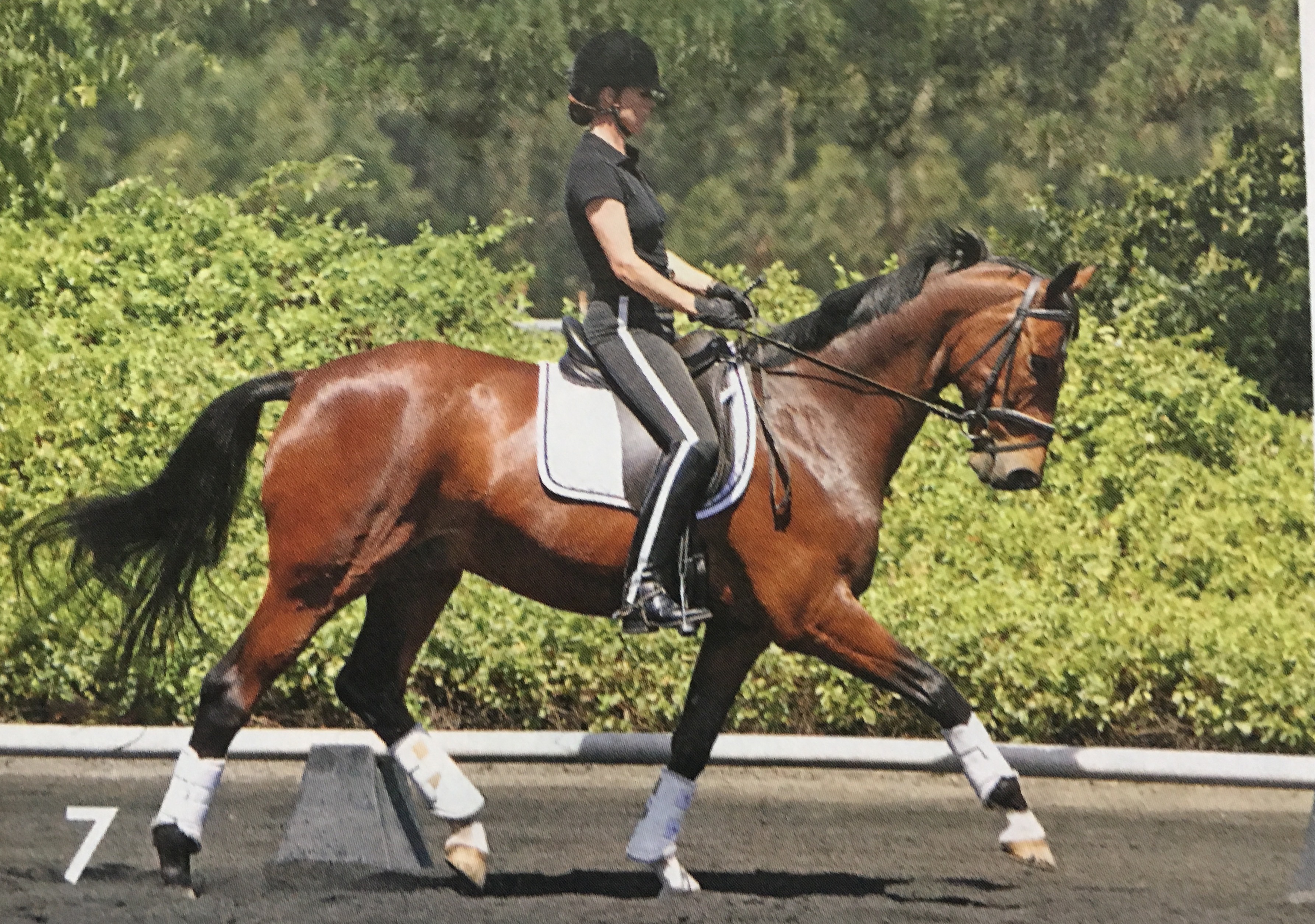
8. My lower legs are loose
Why it’s a problem: You constantly lose your stirrup iron, you have trouble keeping weight in your heels, your leg slips behind the girth and your upper body tips forward over a jump no matter how hard you work to stay steady. A correct lower leg is extremely important because it gives your whole position a foundation.
Fix: Shorten your stirrups so that the angle behind your knee is approximately 90-105 degrees. Your stirrup leather should be perpendicular to the ground, and you could draw an imaginary straight line connecting the back of your heels to your hips to your shoulders. Drop your weight into your heels and turn your toes out anywhere from 35-45 degrees to put the strongest part of your calf—the lower inside back—on your horse’s barrel. If your toe isn’t angled out enough, you’ll have a hard time keeping your calf on; if it’s out too much, your knee will come off the saddle, you’ll have the back of your calf on your horse and your leg won’t be as strong.
To get used to your correct stirrup length and to concentrate on holding your lower leg in the correct position and strengthen it, practice this simple posting-trot exercise: With your leg in the correct position and your body about 25 degrees in front of the vertical, pick up the posting trot. Let your horse’s movement push you up out of the saddle. As you do, feel about 20 percent of your leg pressure shift up from your calf into your knee and thigh—but remember to keep your lower leg at the girth. To reinforce your lower-leg position, as you reach the highest point of your post, make a concentrated effort to push weight into your heels. Descending, use your thigh muscles to ease—not thud—the front quarter of your bottom into the saddle. Post until you feel yourself tiring and your leg slipping out of position. Then take a break for a few minutes at the walk before you pick up the posting trot again.—Frank Madden, November 1995
9. I pinch with my thighs and knees
Why it’s a problem: Pinching tends to turn your heel out and to take your lower leg off, allow it to float back and—when you trot—make it constantly go kablam, kablam, kablam against your horse’s side. If a buck or a bolt or something else happens to break your knees’ grip on the saddle, you’re done for—because what keeps you on a horse is getting your center of gravity as low as you can: down into your heels. If your center of gravity stops at your knees, off you go!
Fix: At the walk, trot and eventually the canter, remove or cross your stirrups and practice these exercises:
- Let your legs hang down; then alternately straighten and bend your knees so they swing independent of your horse’s sides. As your left leg straightens, your right leg bends and vice versa in the next stride.
- Lift your knee straight up—not out to the side—holding it just long enough to break your grip, then let it drop down again.—Lendon Gray, March 1999
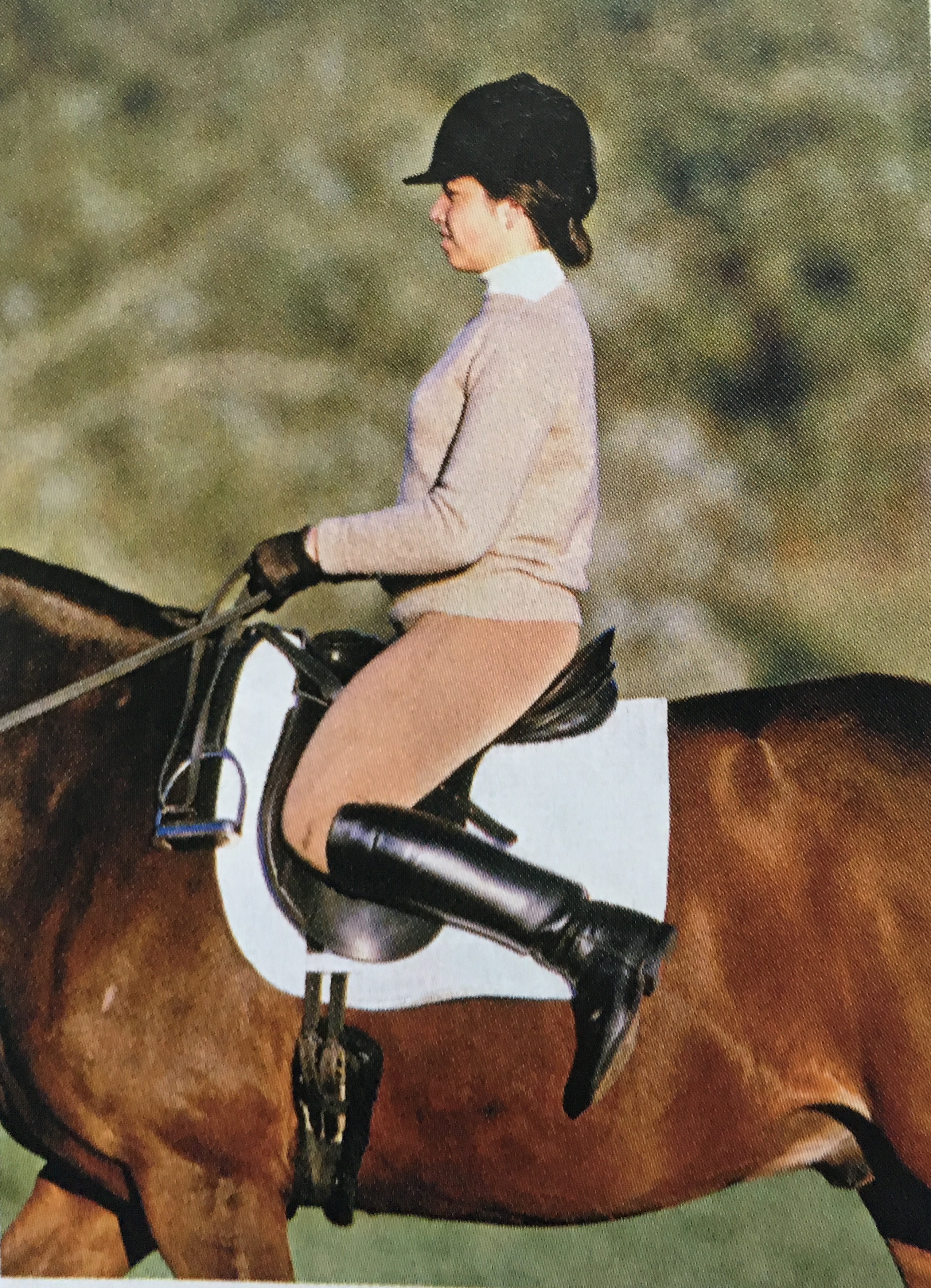
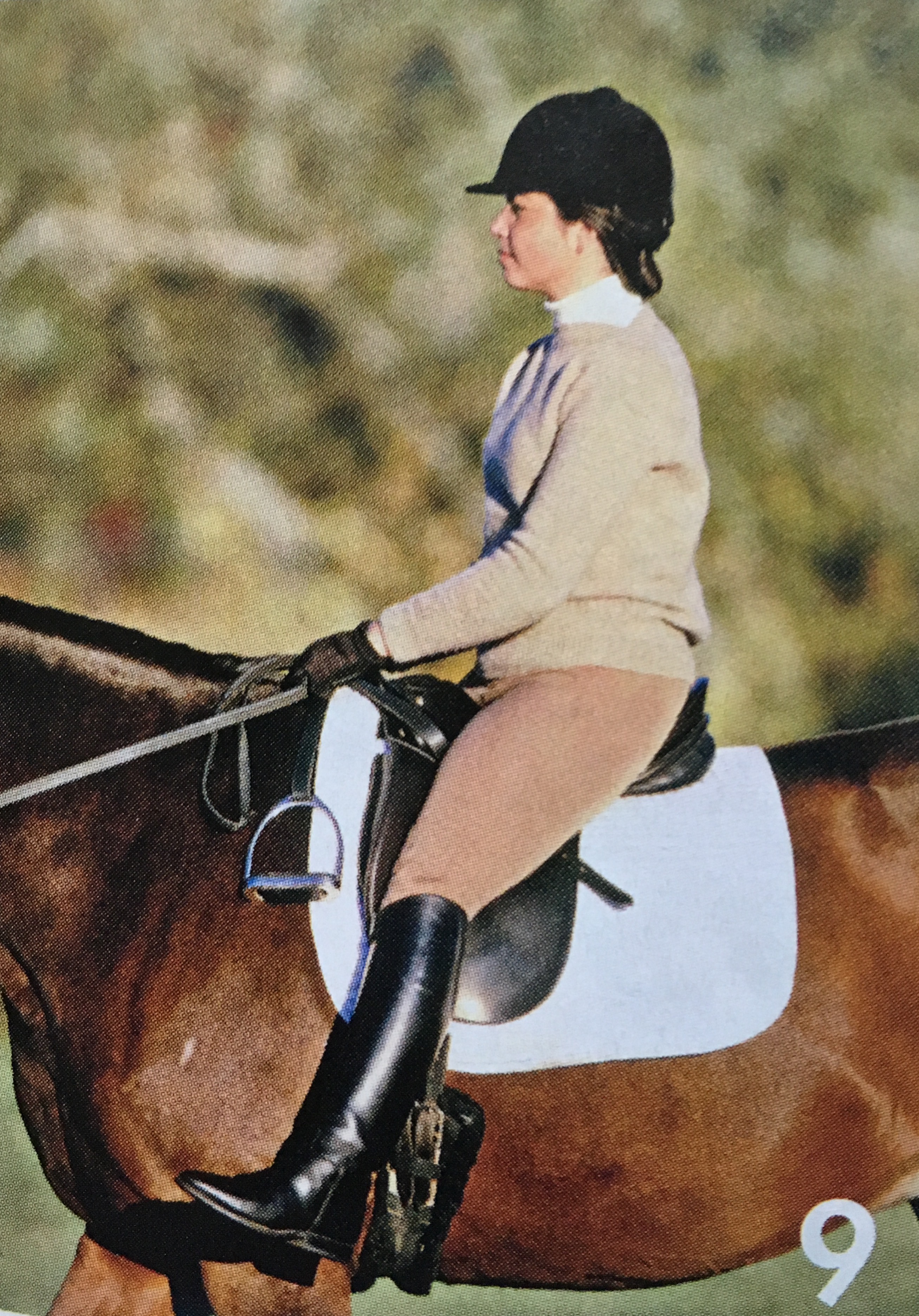
To keep from gripping with your thigh and knee, let your legs hang down, then alternately straighten and bend your knees. As your left leg straightens, you right leg bends and vice versa in the next stride.
10. My heels won’t stay down
Why it’s a problem: Raised heels allow your upper body to topple forward or fall back, especially over fences.
Fix: Start by getting your horse in front of your leg: Step down into your heel and stretch your leg to ask him to go forward. If he doesn’t respond with a more energetic thrust, give him a tap with your stick behind your leg or a touch of the spur.
Now, in the walk, get up in a good old-fashioned two-point. To be sure you don’t just perch on your knee, do this in stages: First, put your hands forward and hold mane so you don’t pull on his mouth. Then, with the ball of your foot on your stirrup iron and your little toe lightly touching the outer branch, step into your heel and start to lift upward. Next, open your knee; and, finally, close your hip. Relax your weight downward. Feel your inner thigh, inner knee and upper inner calf resting near your horse’s side—not because you’re gripping, but because you’re stretching. Drop your heel as much as possible by relaxing your ankle side-to-side (not up and down—ankles don’t work that way). Ride in this balanced two-point position at all three gaits until it feels absolutely automatic.—Pam Baker, March 2001
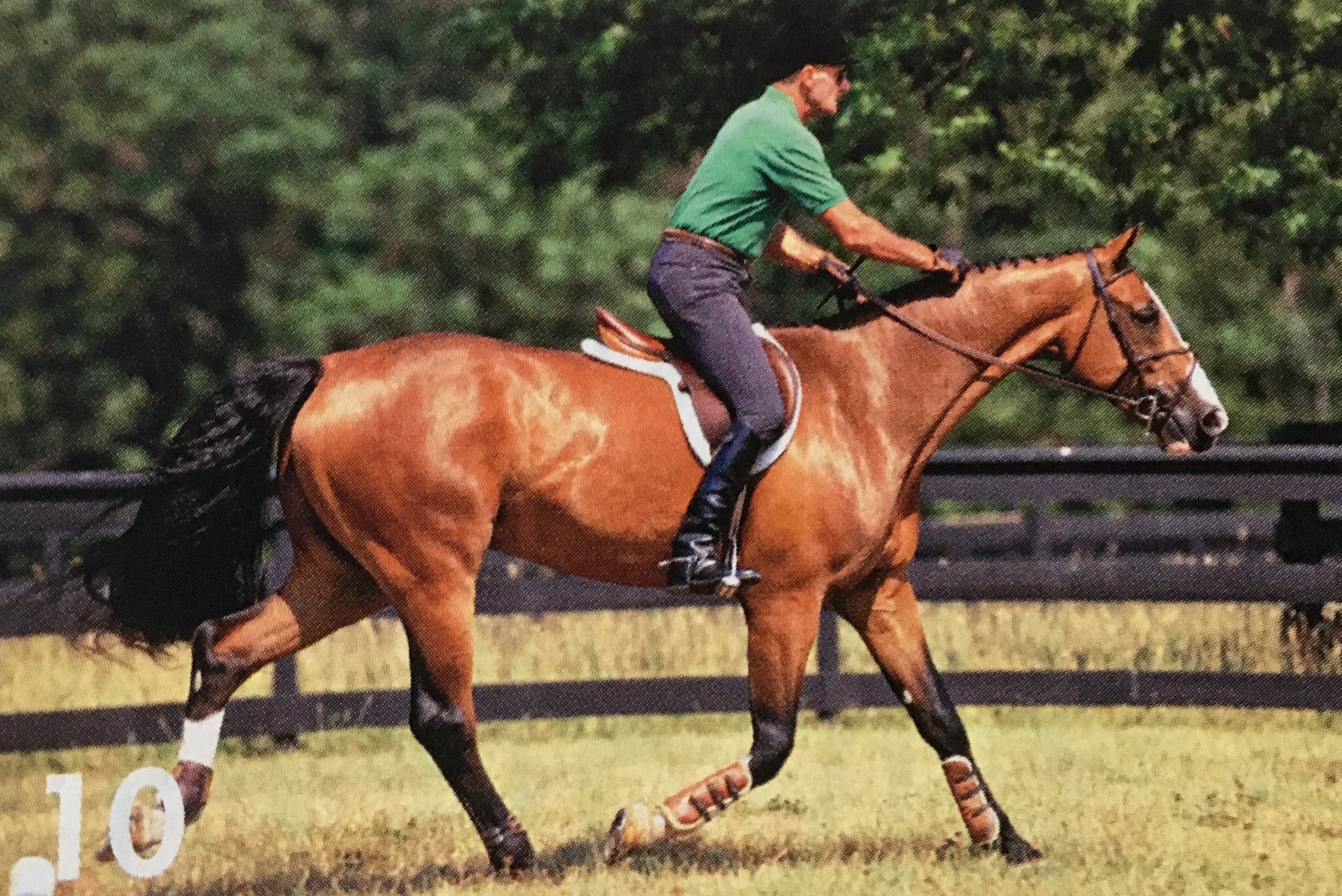
This article was originally published in the April 2010 issue.










